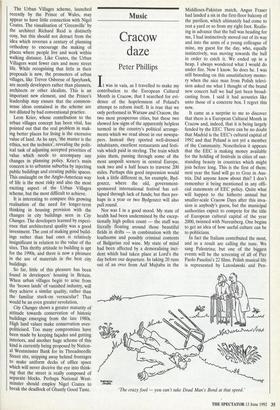ARTS
Architecture
Turning a corner
Alan Powers on the challenges of city sites and urban villages
City Changes (Royal Exchange, till 21 August) Ecstacity (Architectural Association, till 26 June)
Don't, if you are in London, miss the exhibition City Changes at the Royal Exchange. Organised by the Architecture Foundation, it furthers the discussion of London and architecture by selecting a simple theme, new office buildings in the city of London, and presents it so clearly that the confusing reality of the streets is heightened and clarified.
The architecture of the City from 1985 to 1995, including projects not yet built, cer- tainly is confusing. This selection plays down the brash, the colourful and the tacky, all of which have been welcomed under the umbrella of `Post-Modernism'. Instead, we have the big names of British architecture pirouetting on a series of mostly rather small sites with a uniform level of competence, although not always with a command of the visual opportunities offered. Historically, building in the City has always been a job for specialists, albeit mediocre ones. Yet a building like John Belcher's Mappin and Webb, on the corner on Cannon Street and Poultry, the cause célèbre of two public inquiries, shows the consummate skill of a young Victorian architect in turning a corner, something which the whole tendency of modern archi- tecture has managed to make into an awk- ward embarrassment.
Post-Modernists, whatever their short- comings, did get round corners. Terry Far- rell was one who showed that the wisdom of centuries was not wholly lost. Building on the irregular sites of the city, a particu- lar feature of its historical topography revealed in the splendid model in the exhi- bition, calls for qualities of display and panache, tempered by seemliness and pro- bity, suggestive of a successful company chairman, which are only just beginning to re-emerge in architecture.
Panache is the aim of Nigel Coates, whose Ecstacity is on show at the Architec- tural Association. His aim is to regenerate London (the Strand is taken here as an example) into a permanent outdoor night- club. The exhibition is full of words, spoken and written, but the images do little to con- vey what could be attractive about such an idea.
The Prince of Wales with members of the Urban Villages group on a visit to Edinburgh The Urban Villages scheme, launched recently by the Prince of Wales, may appear to have little connection with Nigel Coates. The visualisation of 'Greenville' by the architect Richard Reid is distinctly cosy, but this should not detract from the idea which reverses a century of planning orthodoxy to encourage the making of places where people live and work within walking distance. Like Coates, the Urban Villagers want fewer cars and more street life. While recognising that little in their proposals is new, the promoters of urban villages, like Trevor Osborne of Speyhawk, are mostly developers rather thah planners, architects or other idealists. This is an important new element, and the Prince's leadership may ensure that the common- sense ideas contained in the scheme are not diluted by bad conventional practice.
Leon Krier, whose contribution to the urban villages concept has been vital, has pointed out that the real problem in mak- ing better places for living is the excessive value of land. As he says, 'the master is the ethics, not the technics', revealing the polit- ical task of adjusting accepted priorities of value which needs to accompany any changes in planning policy. Krier's main concern is to urbanise suburbia by injecting public buildings and creating public spaces. This onslaught on the Anglo-American way of life is the most risky and also the most exciting aspect of the Urban Villages scheme, but the most difficult to achieve.
It is interesting to compare this growing realisation of the need for longer-term thinking in housing provision with the changes in city buildings seen in City Changes. The developers learned by experi- ence that architectural quality was a good investment. The cost of making good build- ings rather than bad ones is relatively insignificant in relation to the value of the sites. This thrifty attitude to building is apt for the 1990s, and there is now a pleasure in the use of materials in the best city buildings.
So far, little of this pleasure has been found in developers' housing in Britain. When urban villages begin to arise from the 'brown lands' of vanished industry, will they achieve a similar quality, rather than the familiar stuck-on vernacular? That would be an even greater revolution.
City Changes shows a greater maturity of attitude towards conservation of historic buildings emerging from the late 1980s.
High land values make conservation over- politicised. Too many compromises have been made by keeping façades and gutting interiors, and another huge scheme of this kind is currently being proposed by Nation- al Westminster Bank for its Threadneedle Street site, snipping away behind frontages to make uniform decks of office space which will never deceive the eye into think- ing that the street is really composed of separate blocks. Perhaps National West- minster should employ Nigel Coates to break the deadlock of Ghastly Good Taste.



















































 Previous page
Previous page